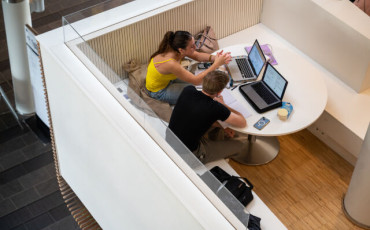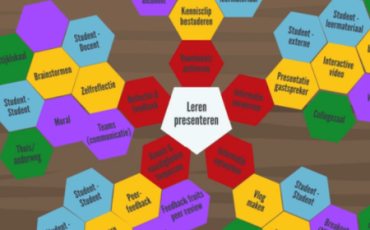Deze maand: blended learning als leermodel in het beroepsonderwijs (een meta-analyse)
Jean Jamin heeft het zesde artikel in deze reeks voor je uitgekozen. Jean is consultant in het team onderwijsinnovatie van Fontys Hogeschool.
Het artikel van de maand oktober is: Krismadinata, K., Verawardina, U., Jalinus, N., Rizal, F., Sukardi, Sudira, P., Ramadhani, D., Luthfini Lubis, A., Friadi, J., Syaiful Rahman Arifin, A. en Novaliendry, D. (2020). 'Blended Learning as Instructional Model in Vocational Education: Literature Review', Universal Journal of Educational Research, 8. http://dx.doi.org/10.13189/ujer.2020.082214
Wat je in dit artikel leest
Dit artikel is het resultaat van een meta-analyse van 45 publicaties over blended learning. Het geeft duiding aan blended learning en de betekenis en het belang ervan in het beroepsonderwijs. De publicaties worden elk kort schematisch toegelicht. Bij elke studie geven de auteurs bovendien (onder andere) de gebruikte methodologie, beperkingen en belangrijkste bevindingen aan. Ook beschrijven zij een aantal leermodellen en de voordelen die in de verschillende studies worden toegekend aan het werken met blended learning. Voordelen die naar voren komen zijn onder meer de flexibiliteit voor lerenden, maar ook verbeterde leerresultaten en een effectievere inzet van de docent in het leerproces.
Waarom we dit artikel hebben geselecteerd
Het artikel verwijst naar 45 aparte (en misschien deels minder voor de hand liggende) bronnen die elk op zichzelf interessant kunnen zijn. Met de analyse en duiding van al deze bronnen krijg je zo al snel een overzicht van mogelijkheden en voordelen die aan het gebruik van blended learning worden toegekend. Ook interessant voor bijvoorbeeld docenten die niet dagelijks bezig zijn met blended learning. Verder biedt het artikel een beknopte toelichting op leermodellen die een aanzet kunnen zijn voor de verkenning van de mogelijkheden in de eigen situatie.
Hoe sluit dit aan op jouw onderwijspraktijk?
Wil je of ben je alweer terug bij ‘normaal fysiek onderwijs’, of ben je een aantal activiteiten online blijven doen? Ben je bewust op zoek naar een mix waarbij on campus en online leeractiviteiten elkaar versterken? Zo ja, helpt dit artikel en de bronnen die daarbij horen daarbij?
Welkom om je gedachten hier te delen!
Kennis over blended learning opdoen
De Special Interest Group (SIG) Blended Learning en de Vraagbaak Online Onderwijs hebben de handen ineen geslagen. Elke maand selecteren deze twee SURF-communities speciaal voor jou een relevant wetenschappelijk artikel over blended learning dat interessant is om te lezen. We stellen je een prikkelende vraag en we stimuleren je om naar je onderwijs / omgeving te kijken en je kennis en ervaring te delen. We vinden het geweldig als je jouw antwoord hieronder of op LinkedIn met ons wil delen!
- Lees hier deel 1 in deze serie over docentstrategieën voor betrokkenheid.
- Hier lees je deel 2 over peerfeedback bij blended learning.
- Lees hier deel 3 over de effectiviteit meten van blended learning.
- Hier vind je deel 4 over gevoel van leren bij actief leren.
- En hier vind je deel 5 over docentprofessionalisering voor blended learning.
Foto door Christopher Burns via Unsplash
The science behind Blended Learning | Part 6: Blended learning as Instructional Model in Vocational Education: Literature Review
Blended learning is one of today’s main topics in higher education. A lot of research on the topic has been conducted over the past years which gives us the opportunity to look at what evidence there is. But it can be daunting. With so many scientific articles, so much information…where to start and what to read? No worries, we’ve got you covered. Each month we’ll pick one scientific paper on blended learning to get you started on expanding your knowledge on the topic.
This month: blended learning as an instructional model in vocational education
Jean Jamin has selected the sixth article in this series for you. Jean is a consultant in the educational innovation team at Fontys University of Applied Sciences.
The article of the month of October: Krismadinata, K., Verawardina, U., Jalinus, N., Rizal, F., Sukardi, Sudira, P., Ramadhani, D., Luthfini Lubis, A., Friadi, J., Syaiful Rahman Arifin A. and Novaliendry, D. (2020). 'Blended Learning as Instructional Model in Vocational Education: Literature Review', Universal Journal of Educational Research, 8. http://dx.doi.org/10.13189/ujer.2020.082214
What to expect in this article
This article explains blended learning and its meaning and importance in vocational education. It concerns a meta-analysis of 45 publications. These are each briefly explained schematically, indicating for each publication, among other things, which methodology was used, what the limitations were and what the most important findings are. A number of learning models are also described and the advantages that are attributed in the studies to working with blended learning. These include flexibility for learners, improved learning outcomes and the more effective use of the teacher in the learning process.
Why we think this article is a must-read
This article refers to 45 separate – perhaps partly less obvious – sources, each of which could be of interest. With the analysis and interpretation of all these sources, even the teacher who is not involved in blended learning on a daily basis, can quickly obtain an overview of the possibilities and advantages that are attributed to its use. Furthermore, the article provides a brief explanation of learning models that can be a starting point for exploring the possibilities in one's own situation.
How does this align with your teaching practice?
Do you want go back or are you already back to 'normal on campus education', or do you continue to do a number of learning activities online? Are you consciously looking for a mix in which on-campus and online learning activities reinforce each other? If so, is this article and its sources helpful?
Welcome to share your thoughts here!
Gaining more scientific knowledge on blended learning
SURF’s Special Interest Group (SIG) Blended Learning and Vraagbaak Online Onderwijs will be working together from now on. Each month they will provide you with a relevant article on blended learning and an inspiring question. Easy, accessible and up to date. We invite you to share your thoughts on the selected articles either here or on LinkedIn.
Previous articles in this series:
- Part one: Strategies to foster student engagement.
- Part two: Peer feedback in a blended learning environment.
- Part three: Evaluating the effectiveness of blended learning.
- Part four: Measuring actual learning versus feeling of learning.
- Part five: Professional development for blended learning in higher education.
Photo by Christopher Burns on Unsplash



0 Praat mee